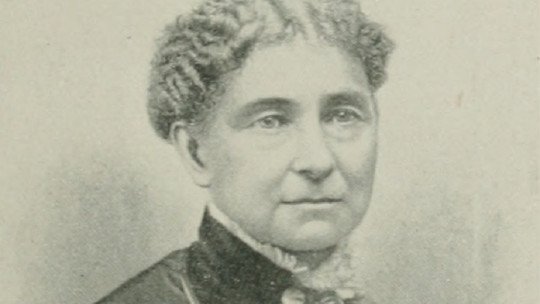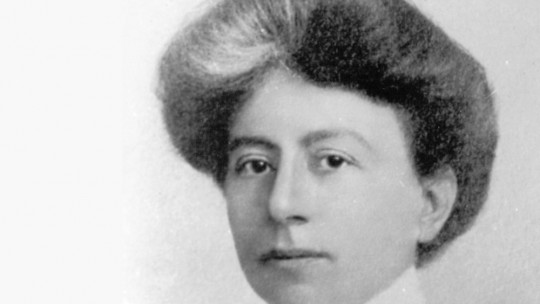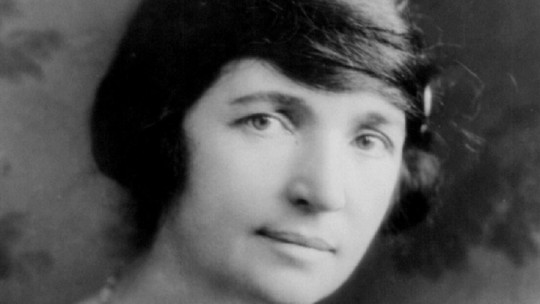Although it is already part of the past, at least in the Western world, it was not long ago that women were considered beings with delicate hands, made for sewing, drinking tea and raising children, while they were the men who, through political struggle, were in charge of state affairs.
But all this changed when Victorian women, fed up with being denied the right to vote, took action. Under the slogan “deeds, not words” Emmeline Pankhurst fought for women’s suffrage to be recognized.
Her life is that of a fighter, a woman who did not limit herself to an intellectual life but participated in numerous protests, many of them not very peaceful but, thanks to them, women have their right to vote recognized. Let’s discover her story through a summary biography of Emmeline Pankhurst
Brief biography of Emmeline Pankhurst
Emmeline Pankhurst, née Goulden, was born in Manchester, England, on 15 July 1858 , although as an anecdote we can comment that she always defended having been born on the 14th. From a very young age she read “Women’s Suffrage”, a publication that her mother bought every week since the young Emmeline’s family was politically active, sensitized to the situation of the oppressed people. Her father, Robert, was an anti-slavery businessman, and her mother, Sophia, was a passionate feminist.
Youth and contact with the suffragettes
Despite his family’s political interests and being against the way things were in his time, Emmeline’s parents preferred to raise their daughter to be a good wife and mother , in line with what was expected of a woman in Victorian society. However, the young woman did not agree much with these ideas and that is why, at only 14 years old, after attending a speech in favor of women’s rights, Emmeline decided to join the British suffrage movement.
Shortly after, he had the opportunity to live in Paris, where he would attend the École Normale de Neuilly. France, or at least its capital, was a less conservative place than its neighbor Great Britain, so women had access to rather limited knowledge in other parts of Europe. This is why young Emmeline would have the opportunity to study chemistry and accounting, but she would also have to take subjects considered feminine, such as embroidery.
First years of demands
In the autumn of 1878 she began her relationship with Richard Pankhurst, a lawyer 24 years her senior. Richard was a socialist and was very committed to the fight for women’s suffrage. The couple, despite their age difference, hit it off in a very short time and just a year later they married with the approval of the bride’s parents. The connection between the two was both political and romantic and Emmeline’s parents were very happy to have such a brilliant lawyer in the family.
The marriage between Emmeline and Richard Pankhurst was appropriate for her class and her time, having four children in the first six years of her life. However, they differed from the others by being members of the Independent Labor Party and the suffrage movement. The couple would found the “Women’s Franchise League” (WFL), which advocated for both married and single women to have the right to vote
The WFL was considered a radical organization, an opinion that became even more so when the organization began to fight in favor of considering men and women equal in aspects such as divorce and inheritance. He advocated unionism and tried to seek alliances in political socialism. However, its ideas were too advanced for this time and even several of its suffragette members saw them as too radical, abandoning the organization and causing it to end up falling apart.
Your activism: actions, not words
In 1898 Richard Pankhurst died due to a perforated ulcer which leaves Emmeline under the responsibility of many debts. That is why she began working at the Chorlton Birth and Death Registry, near Manchester, where she would have the opportunity to learn first-hand about the lives of many women, seeing the true differences in the rights recognized between men and women.
In 1903 Emmeline realized that the moderate speeches on women’s suffrage that were taking place in parliament were leading nowhere. She is disappointed by the results of the moderate suffragettes decided to found the “Women’s Social and Political Union” (WSPU) In it, Emmeline publicly defended women’s suffrage, and in one of her speeches she pronounced her slogan “Deeds, not words,” which would end up becoming the movement’s motto.
The group began to assert itself through nonviolent action, making speeches, collecting signatures, organizing demonstrations, and publishing a newsletter called “Votes for Women.” She also convened a “Women’s Parliament”, which met by coinciding with those of the official Parliament.
On May 12, 1905, Pankhurst and several colleagues from the WSPU They gathered in front of Parliament to demonstrate in favor of an amendment regulating women’s suffrage The police showed up to disperse them, but the group later re-formed and continued to demand approval. Although the amendment was not approved, Emmeline Pankhurst, seeing the pressure capacity of such a demonstration, pointed out that her protest had turned them into a true political force.
Imprisonment as an act of protest
Emmeline’s daughters, Christabel, Adela and Sylvia, were active members of the WSPU and, as a result, were arrested on more than one occasion. The first time Emmeline Pankhurst was arrested was in 1908, after attempting to enter Parliament to deliver a protest to the Prime Minister. She spent six weeks in prison, which helped her learn about the deplorable conditions in which the prisoners were found and it was at that moment that Emmeline Pankhurst decided to turn imprisonment into her means of protest.
She did everything possible to have her arrested and imprisoned. This, which may seem like an almost suicidal mission, had a powerful intention: to show the world that she was not being detained for committing crimes, but for wanting to become a legislator. Emmeline Pankhurst was arrested up to seven times before women’s suffrage was approved in the United Kingdom.
On June 26, 1908, thousands of activists gathered in Hyde Park to demand women’s suffrage At the end of the demonstration, several WSPU activists gathered to give speeches but the police came and detained several attendees. Out of frustration, two members of the formation, Edith New and Mary Leigh, threw stones at the windows of the Prime Minister’s home. Although they themselves said that their events were not organized by the WSPU, Emmeline Pankhurst pointed out that she was in favor of them.
In 1909, following the imprisonment of Marion Wallace Dunlop, a suffragist who went on hunger strikes in prison, the WSPU decided to adopt this new pressure strategy. Several suffragettes attempted hunger strikes, but prison officials force-fed them by inserting tubes into their noses or mouths. Both the suffrage movement and medical professionals harshly criticized these measures.
The gap between the suffragism advocated by Emeline Pankhurst and that advocated by more moderate suffragettes caused some of the WSPU members to begin to use the term “suffragete” instead of “suffragist” to differentiate themselves from moderates who, as we have mentioned before, did not seem to be contributing significantly to the movement.
In 1907 Emmeline Pankhurst sold her house to begin a busy lifestyle. She moved from one place to another demanding women’s suffrage, staying in hotels or in the homes of acquaintances. In 1909 he traveled throughout the United States to give a series of lectures to obtain funds for his cause in addition to being able to cover the expenses of the illness that his son Henry was suffering from.
The law of cat and mouse
After the 1910 elections, a Conciliation Committee for Women’s Suffrage was organized. The WSPU suspended its protest actions while a bill to give women voting rights was being negotiated. The project did not go ahead, which caused Pankhurst to lead the a protest march with more than 300 women heading to Parliament Square There they were received with police repression led by the Home Secretary, Winston Churchill, an event that would be known as Black Friday.
In March 1912 a second bill was rejected. It was another straw that broke the camel’s back and, already fed up with so many refusals, several members of the WSPU, including Emmeline Pankhurst, intensified their actions. The police responded by raiding their offices and pursuing her daughter Christabel, who was the organization’s main coordinator, who had to go into exile to Paris. Emmeline was arrested and convicted of conspiracy, which led her to organize her first hunger strike in cell.
Public opinion was scandalized by the treatment and harassment that the suffragettes received by the police, so the authorities decided to apply a new strategy to repress the movement: the law of cat and mouse. The cat was the government, which released the mice, who were the suffragettes, when their health worsened. Once they recovered and returned to the political struggle, the government again persecuted and locked them up. But the WSPU was already a large pack of mice, with more than 100,000 members.
The WSPU had long ago abandoned peaceful activism and opted for more invasive measures , including fire as a weapon of protest. Several activists tried to cause explosions and set fire to various places during 1913 and 1914. Although Emmeline and her daughter Christabel indicated that these actions had not been approved by the organization, they did support them.
One of the best-known acts perpetrated by members of the WSPU is that of Mary Richardson who, in 1914, slashed the painting by the Spaniard Diego Velázquez “Venus in the Mirror” from 1647, in protest of Pankhurst’s imprisonment. Although with the passage of time this canvas would be restored, such action against a piece of art was very controversial and, at the same time, intensified pressure on the government and society.
In November 1917 the WPSU became the Women’s Party A year later Christabel announced that she was running as her candidate in the next election, the first in which women could run. The candidate lost to the Labor candidate by 775 votes, which led the party to not stand in another election and, shortly after, to disintegrate.
Partial victory in his last years
A few months later, women’s suffrage would be approved, although partially, since only women over 30 years of age could vote The reason for this was that the idea was still well established that women matured much later than men and that they were not mentally adults until they were in their thirties. This was not satisfactory to the suffrage movement, but it was better than nothing. Likewise, they did not leave the fight behind and fueled by this victory they continued to exert pressure.
But Emmeline Pankhurst’s time was growing short. Just when she was approaching her main purpose in life, that is, that all women could vote, Emmeline Pankhurst’s health worsened and she had to enter a home for the elderly. It would be there where he would spend his last days, dying on June 14, 1928, at the age of 69 A little over a month later, on July 21, the government extended the right to vote to all women, both married and single, over 21 years of age.









